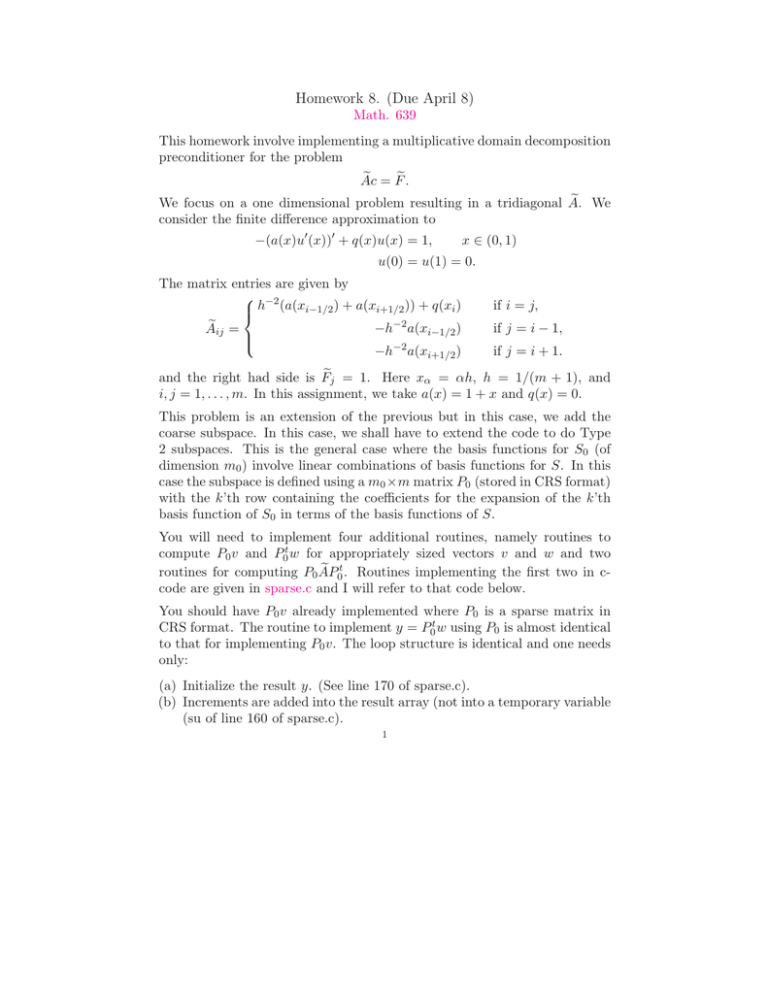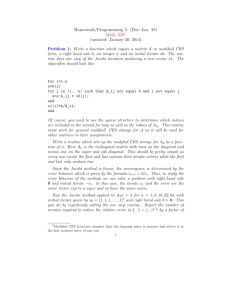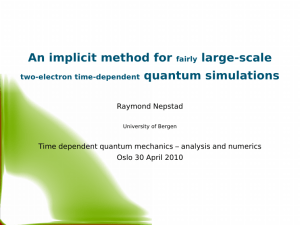Homework 8. (Due April 8)
advertisement

Homework 8. (Due April 8) Math. 639 This homework involve implementing a multiplicative domain decomposition preconditioner for the problem e = Fe. Ac e We We focus on a one dimensional problem resulting in a tridiagonal A. consider the finite difference approximation to −(a(x)u′ (x))′ + q(x)u(x) = 1, x ∈ (0, 1) u(0) = u(1) = 0. The matrix entries are given by −2 h (a(xi−1/2 ) + a(xi+1/2 )) + q(xi ) eij = −h−2 a(xi−1/2 ) A −h−2 a(xi+1/2 ) if i = j, if j = i − 1, if j = i + 1. and the right had side is Fej = 1. Here xα = αh, h = 1/(m + 1), and i, j = 1, . . . , m. In this assignment, we take a(x) = 1 + x and q(x) = 0. This problem is an extension of the previous but in this case, we add the coarse subspace. In this case, we shall have to extend the code to do Type 2 subspaces. This is the general case where the basis functions for S0 (of dimension m0 ) involve linear combinations of basis functions for S. In this case the subspace is defined using a m0 ×m matrix P0 (stored in CRS format) with the k’th row containing the coefficients for the expansion of the k’th basis function of S0 in terms of the basis functions of S. You will need to implement four additional routines, namely routines to compute P0 v and P0t w for appropriately sized vectors v and w and two e t . Routines implementing the first two in croutines for computing P0 AP 0 code are given in sparse.c and I will refer to that code below. You should have P0 v already implemented where P0 is a sparse matrix in CRS format. The routine to implement y = P0t w using P0 is almost identical to that for implementing P0 v. The loop structure is identical and one needs only: (a) Initialize the result y. (See line 170 of sparse.c). (b) Increments are added into the result array (not into a temporary variable (su of line 160 of sparse.c). 1 2 (c) Indices on the left and right are switched (see line 162/163 and 173). e and P0 AP e t are symmetric and tri-diagonal. To For this assignment, both A 0 build the diagonal and off diagonal, you need routines: e with P0 in CRS (a) You need to develop a routine for computing B = P0 A e tri-diagonal. If the j’th row of P0 has l entries, the the j’ format and A row of B has at most l + 2 entries. Compute the rows of B one row at a time. This enables you to build the CRS structure of the product one row at a time. (b) Next you need to develop a routine for computing C = P0 B t with P0 and B in CRS format. For this assignment, C is symmetric tri-diagonal and you may assemble it in this structure, i.e,, compute only D and LD. This e t = P0 B t is relatively easy but involves some testing. Then A0 = P0 AP 0 e gives the D,LD structure for the coarse grid matrix A0 . with B = P0 A In this assignment, we shall use exact subspace solvers but implement the product algorithm. The preconditioner Bm (tF ) implements as: set v=0; // a vector of length m, tF a given inner product vector for j=1:l-1 // assuming type l-1 standar overlapping spaces // 0 is the coarse space R=tF-tA v; // you need a routine for computing tA v Fj=subIP1(R,PJ(j)); si=solve(tA_j,Fj); v=subCoefadd1(v,si,PJ(j)) // v=v+PJ(j)^t*si end // coarse grid space R=tF-tA v; // you need a routine for computing tA v F0=sparsemult(R,P_0); // F0= P_0 * R si=solve(A_0,F0); v=sparsemulttrans(v,si,P_0) // v=v+P_0^t y for j=l-1:1 // assuming type l-1 standar overlapping spaces // 0 is the coarse space R=tF-tA v; // you need a routine for computing tA v Fj=subIP1(R,PJ(j)); si=solve(tA_j,Fj); v=subCoefadd1(v,si,PJ(j)) // v=v+PJ(j)^t*si end Set B_m tF = v. 3 The non-coarse subspaces are as in the previous assignment. Problem 1. Apply your preconditioned conjugate gradient (PCG) iteration procedure (with the above right hand side and zero initial iterate) using Bm as a preconditioner. and report the estimates for the largest and smallest em A e computed by PCG as well as their quotient (the estimate eigenvalues of B for the condition number). Do this for the following combinations of l and m. (i) (ii) (iii) (iv) l = 4, m = 15, 31, 63, 127, 255, 511, 1023. l = 8, m = 15, 31, 63, 127, 255, 511, 1023. l = 16, m = 15, 31, 63, 127, 255, 511, 1023. l = 4, 8, 16, 32, 64, 128, m = 2047 You should see uniformly bounded condition numbers for all combinations.




